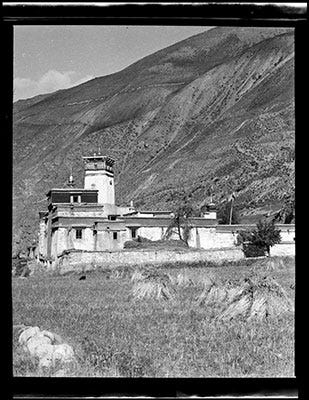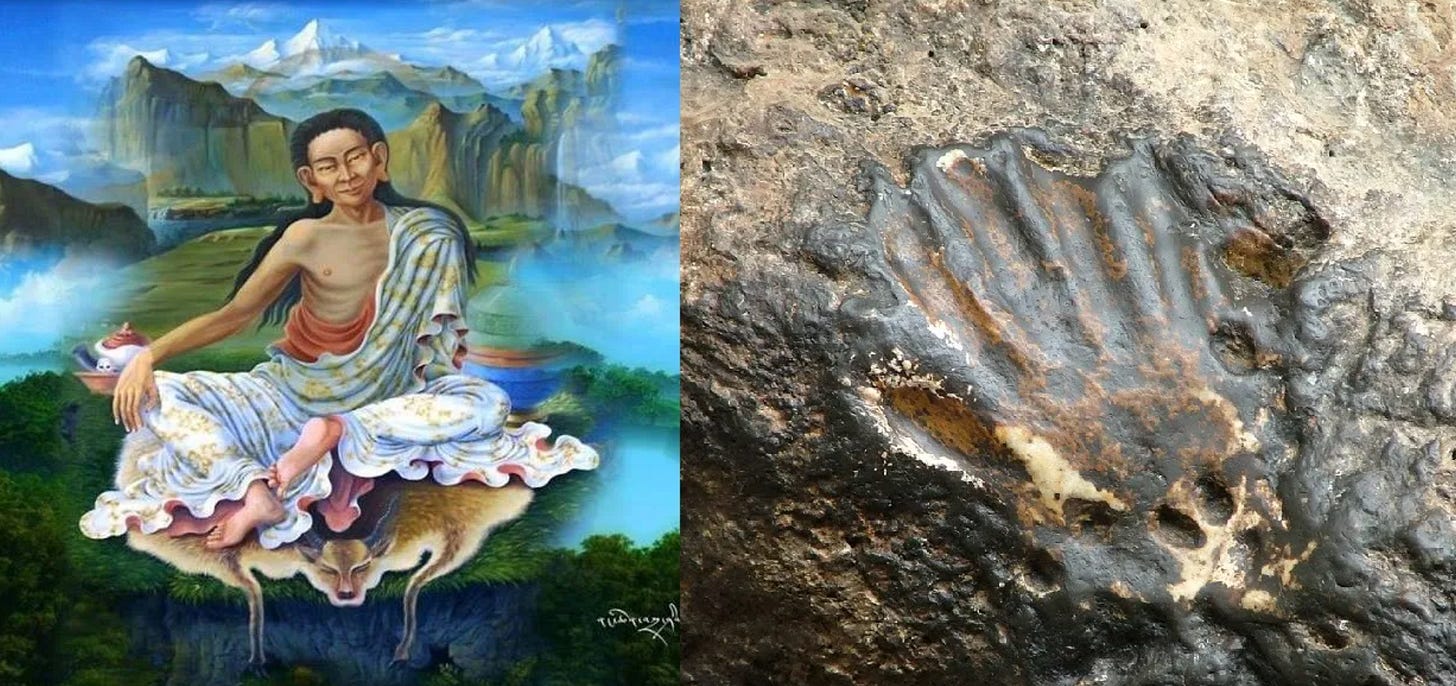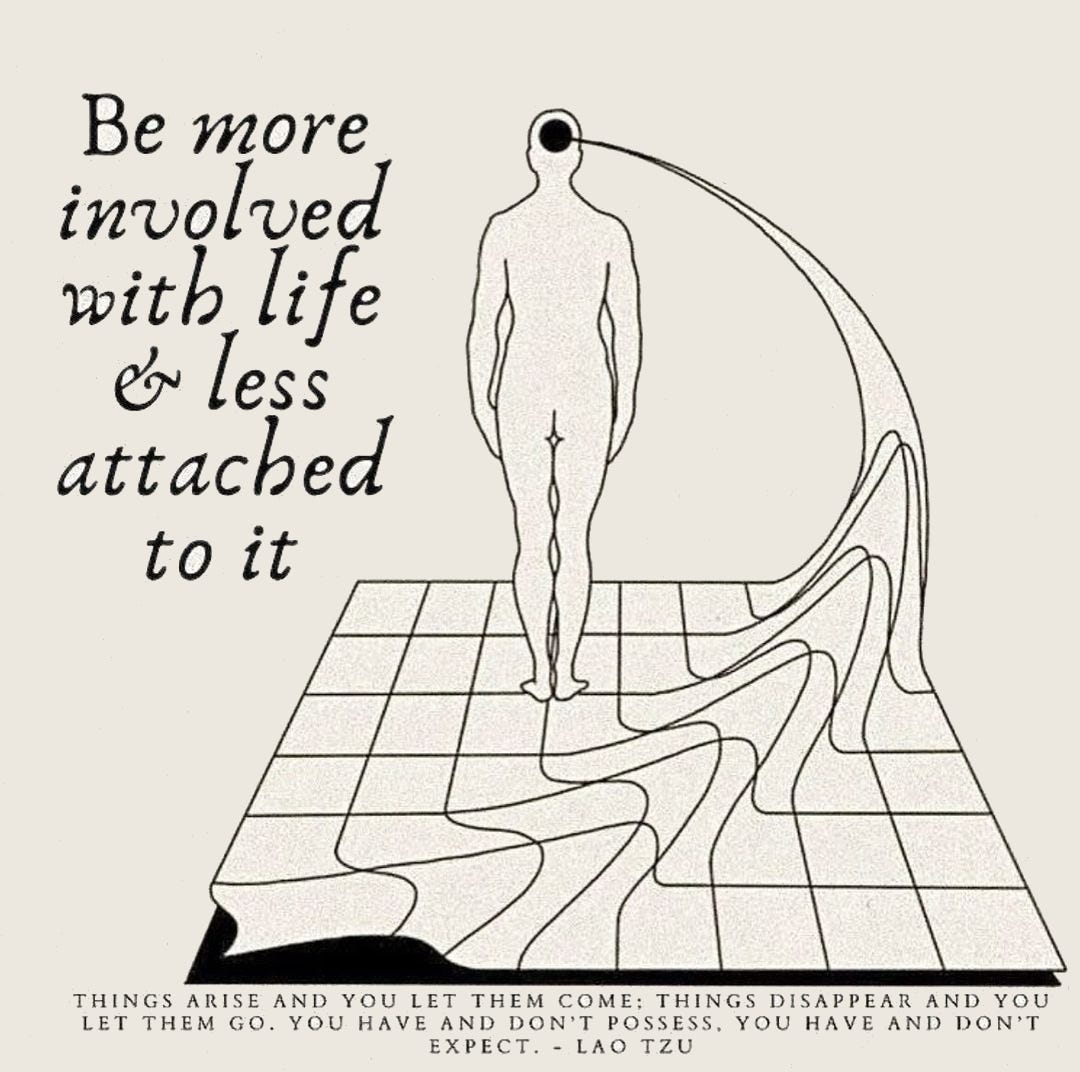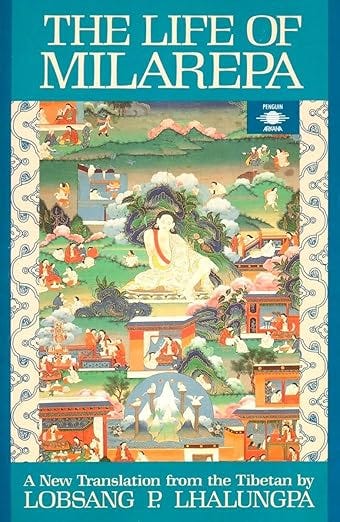The Handprint In The Cave
How Milarepa's Nonduality Can Help Us Detach and Uplift
"All worldly pursuits have but one unavoidable and inevitable end,
which is sorrow:
acquisitions end in dispersion;
buildings in destruction;
meetings in separation;
births in death.
Knowing this, one should, from the very first,
renounce acquisitions and storing-up,
and building,
and meeting;
and, faithful to the commands of an eminent Guru, set about realizing the Truth.
—Milarepa
Let’s consider the "futility" of the material world of form.
Oxford defines “futility” as:
pointlessness or uselessness.
As in: "the horror and futility of war"
That's the word and sensation that came up for me after reading The Life of Milarepa, a medieval biography of an ancient Tibetan Buddhist saint who broke through the veil.1
It is an idea that comes up again and again in the mystic traditions.
This world is emptiness. It’s a Cosmic Dream. Even according to the 2022 Nobel Prize in Physics, so-called “reality” doesn't have a fixed state until it's measured.2
Certainly this is a foundational concept in two of my spiritual pillars, Advaita Vedanta and A Course in Miracles. In fact that's their biggest overlap—worrying too much about form is not only pointless, but that a fixation on form (this world) actually prevents our reunion with the Father (ACIM) or the Self (Advaita).
Milarepa (ca. 1028–1111) was a redeemed "great sinner" (his words), thanks to his Shakespearean upbringing. His respected, prosperous father died young, leaving his estate to the boy Milarepa’s uncle and aunt until he came of age. Instead of being faithful stewards of their late brother’s riches, the uncle and aunt squander the money and essentially enslave young Milarepa, his sister, and his grieving widow of a mother. After years of abuse, his tortured mother told her son to go learn black magick from a teacher in the mountains and take retribution against their evil stewards. After his initial resistance, she threatens to end her own life if he doesn’t do so. He does. After years of study he obtains the ability to call in hailstorms, generating an especially powerful storm on the day of a great wedding party, when his evil uncle’s family is gathered in celebration. The storm destroys the house, killing at least thirty people, ruining their bountiful harvest, and wrecking the boy Milarepa with unbearable guilt.
He begins his trek through the snowy peaks to find a teacher that can help him repent and develop along a true spiritual path. After what becomes three failed teachers, Milarepa meets the great master, Marpa the Translator, a householder lama and disciple of Naropa who translated several Buddhist texts into the Tibetan language.3 The night before Milarepa’s arrival, Marpa has a vivid, prophetic dream that a Buddha is on his way. However, their initial relationship was extraordinarily difficult. Marpa coldly instructs Milarepa to build a building, and destroy it. Several times! ‘Not over there, over here! Destroy it and build it in the correct location…’ The final building that Milarepa constructed with his own hands is a nine-story tower still standing today!
Six long years passed without an ounce of oral transmission. He carried on with a battered body of aching shoulders, infected hands, and immense existential uncertainty. Until finally, Marpa confesses that it was all an act. He purposefully had to put his beloved student through hell in order to run off all of the evil karma that was generated from his teenage murders. The teachings are given, and at last Milarepa is instructed to practice them in the distant snowy peaks.
He meditated in the mountain caves of Tibet for YEARS. And we need an app and nice headphones to sit for 10 minutes. Milarepa is often pictured with green skin, because he meditated in isolation for so many years, he would cook a makeshift stew of boiled nettle leaves. Grass soup. When the occasional hunter or traveler stumbled upon his cave, they were initially terrified of what appeared to be a green ghost absorbed in meditation. Eventually, Milarepa broke through into the Complete Awareness. The Highest Transcendental Reality beyond form, beyond definition. He’s as extraordinary and miraculous as any saint I've stumbled across... he even appears to his disciples after his death, like a few other famous spiritual teachers.
One of the most miraculous moments in his story is a demonstration he gives toward the end of his life. Milarepa left a hand imprint on a cave wall which can still be seen today. How could he do this? A Tibetan tour guide told spiritual teacher, Gregg Braden:
“The great master’s meditation teaches that he is part of the rock, not separate from it. The rock cannot contain him. To the geshe [great teacher], this cave represents a place of experience, rather than a barrier of limitation. In this place he is free and can move as if the rock does not exist.”4
There is no spoon.
What he teaches is extreme discipline in meditation and detachment from the world of form. Milarepa saw that everything falls apart here. Everyone is busy running around rearranging these Titanic deck chairs. It doesn’t matter how neatly aligned they are. They’re about to be at the bottom of the ocean.
From one of his ‘ten thousand songs’:
When you are young and vigorous
You never think of old age coming,
But it approaches slow and sure
Like a seed growing underground.
Strong and healthy,
Who thinks of sickness
Until it strikes like lightning?
Preoccupied with the world,
Who thinks of death
Until it arrives like thunder?
Who can tell when death will come?
Ever think of this,
And devote yourselves
To Dharma practice.
The time has come for you to help yourself.
Life flees fast. Soon death
Will knock upon your door.
It is foolish, therefore, one’s devotion to postpone.
Rest in a natural way like a small child.
Rest like an ocean without waves.
Rest within clarity like a candle flame.
Rest without self-concerns like a human corpse.
Rest unmoving like a mountain.
Long accustomed
To contemplating compassion,
I have forgotten all difference
Between myself and others.
In the monastery of your heart and body,
you have a temple where all buddhas unite.
When one comes to the essence of being,
The shining wisdom of reality Illumines all
Like the cloudless sky.
But isn’t that apathy? I’m not going to sit around and do nothing. People are suffering and they need our help. Milarepa tells us that trying to “help” another, while still caught in the veil of illusion is like jumping into a rushing river to save a drowning man without knowing how to swim.
The beautiful nuance of Milarepa’s view on nonduality is his embodiment as a bodhisattva. Milarepa’s bodhisattva nature is seemingly ironically, entirely dedicated to the service of other beings. In meditation, he’s continuously praying for the upliftment of all. Many of his songs close with this intentionality. It is precisely his intense, loving focus on the betterment of all sentient beings that motivates his austerities!
His 15th century biographer, a Buddhist Kagyu “religious madman” Tsangnyön Heruka, writes:
“[Milarepa] engendered in himself such an intense and far-reaching enlightened awareness (Bodhicitta) that by listening to him or even by hearing his name human beings who had no inclination toward the Dharma were moved to tears of faith, causing the hairs on their bodies to vibrate, and bringing about such a transformation of their whole perception that the seed of Enlightenment was sown in them...”5
This world is a crazy place. It’s easy to become disheartened by the violence, hunger, war, catastrophes, and the tangible, totality of suffering.
And yet after over twenty years of spiritual study, I have not once stumbled across an authentic spiritual teaching that suggested we be apathetic to the suffering of others. Apathy and indifference are not spiritual—they are egoic, and that’s not what the great women & men mystics of the past who’ve beaten samsara prescribe for us.
But we shouldn’t get caught either.
Jesus makes the subtle distinction to be ‘in the world, but not of the world’ in John 17. In the apocrypha, he tells us to “be passersby”. This world is a bridge. We are to “cross over it", but not to build “our home here.”6
Milarepa’s incarnation is a phenomenally inspiring life story of a human being who endured countless painful hardships in his life, from a very early age. And he overcame it all, including his own murderous past. His unparalleled devotion to the practice of deep meditation and lovingkindness melted away all delusion of separation, lifting up so many millions of seekers in the past millennia.
The 20th century Tibetan Buddhist monk and translator of Life of Milarepa, Lobsang P. Lhalungpa, illuminates us in the prologue:
“…The aim is to cultivate goodness consciously in thoughts, words and deeds to become a ‘jewel among humanity.’ From the outset, one works to free oneself from all superstitious complexes of superiority or inferiority based on sex, race, color, or creed. A deeper sense of one entire human family and universal fellowship has to be developed as the foundation for a right attitude to human relationships. Only then is the seeker led toward a process of spiritualization.
…Without this preparatory development of a sound and sane basic attitude toward the goals of living, the whole spiritual endeavor is susceptible to egoistic self-love, as distinguished from a practical concern for one’s permanent freedom. For even where consciousness has achieved an exalted level, its need must be further developed into an effective instrument for the process of universal emancipation of all human beings.”7
Mindfulness for Schoolteachers: Program Pilot Results
While I am happily dedicated to releasing more episodes of Karmic Relief Podcast, and building more content on my humble YouTube channel, I am also the co-founder of a mindfulness initiative focusing on teaching mindfulness and meditation to schools—both students and teachers.
Our main offering is a 6-10-week MBSR-type program called The Aware Educator, and I’m thrilled to share that we saw significant improvements in attention and awareness among our first teacher participants! In our pilot study with 40 K-5 teachers in Queens, New York, we utilized the Mindfulness Attention Awareness Survey (MAAS) to measure the impact of our program.
Before the program, the average MAAS score for the group was 3.758.
After completing the program, the average score rose to 4.155!
To put this into perspective, research by Positive Psychology indicates that the average score for undergraduate students is 3.85, while Zen meditators score an average of 4.38.
Our results show a notable enhancement in mindfulness, bringing our educators closer to the level of experienced meditators. If you’re a schoolteacher or associated with leadership in your school, please do book a call with us to learn more.
Thanks for reading,
Bob
Heruka, Tsangnyön, and W. Y. Evans-Wentz. The Life of Milarepa. Translated by Lobsang Phuntshok Lhalungpa, Penguin, 1992
Wood, Charlie. “Pioneering Quantum Physicists Win Nobel Prize in Physics.” Quanta Magazine, 6 Oct. 2022, www.quantamagazine.org/pioneering-quantum-physicists-win-nobel-prize-in-physics-20221004/#:~:text=But%20most%20researchers%20take%20the,new%20research%2C%E2%80%9D%20said%20Zeilinger.
Leonteva, Lena, et al. “Marpa the Translator.” Buddhism Today Magazine, 17 June 2024, buddhism-today.org/marpa-the-translator/.
Braden, Gregg, and Joe Dispenza. “Foreword.” Becoming Supernatural: How Common People Are Doing The Uncommon, Hay House, Carlsbad, CA, 2017, p. xiii.
Heruka, Tsangnyön, and W. Y. Evans-Wentz. The Life of Milarepa. Translated by Lobsang Phuntshok Lhalungpa, Penguin, 1992, p3.
“Gospel of Thomas, Saying 42.” Gospel of Thomas Saying 42 - Early Christian Writings, www.earlychristianwritings.com/thomas/gospelthomas42.html. Accessed 30 July 2024.
Heruka, Tsangnyön, and W. Y. Evans-Wentz. The Life of Milarepa. Translated by Lobsang Phuntshok Lhalungpa, Penguin, 1992, Prologue, xv.








🔥